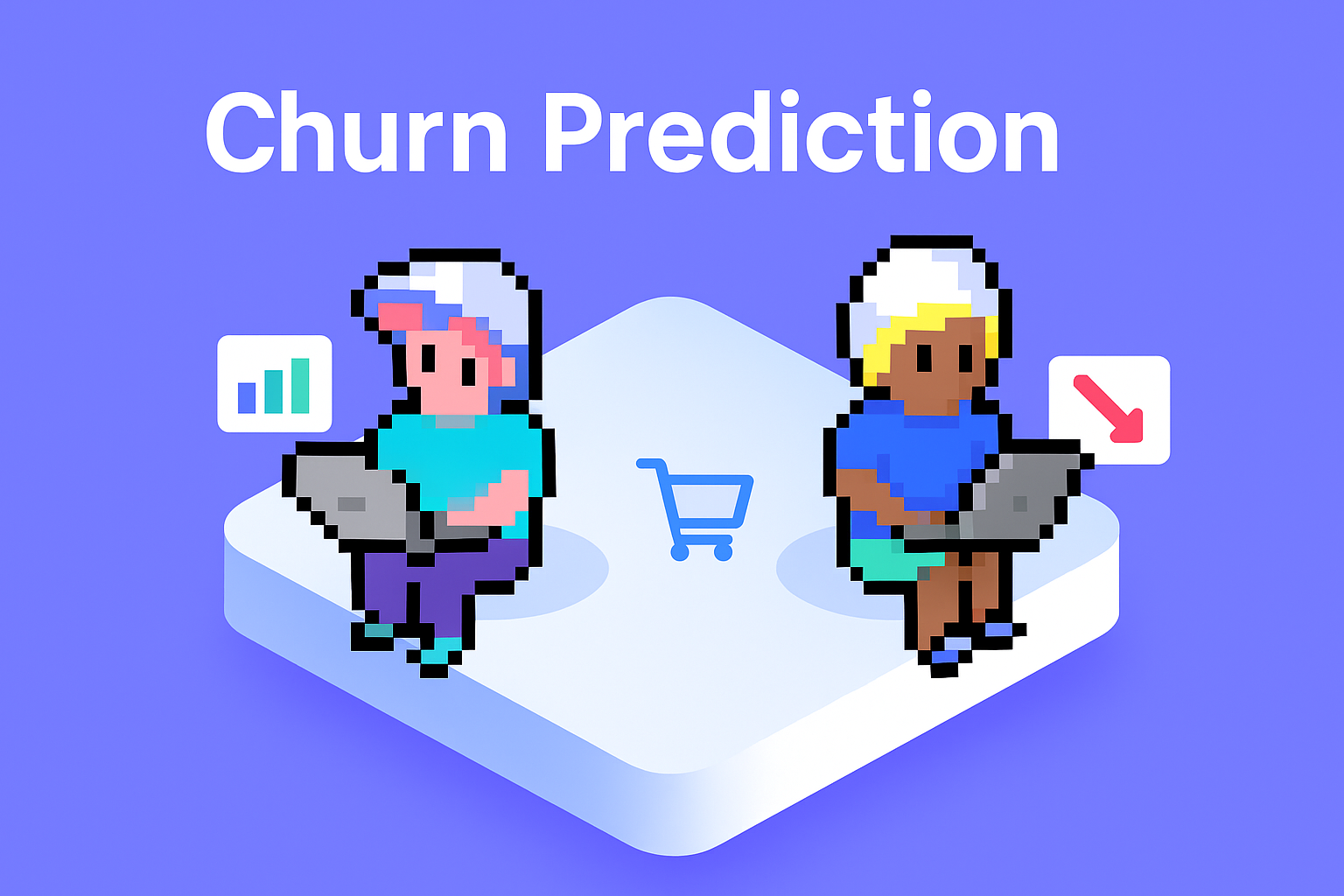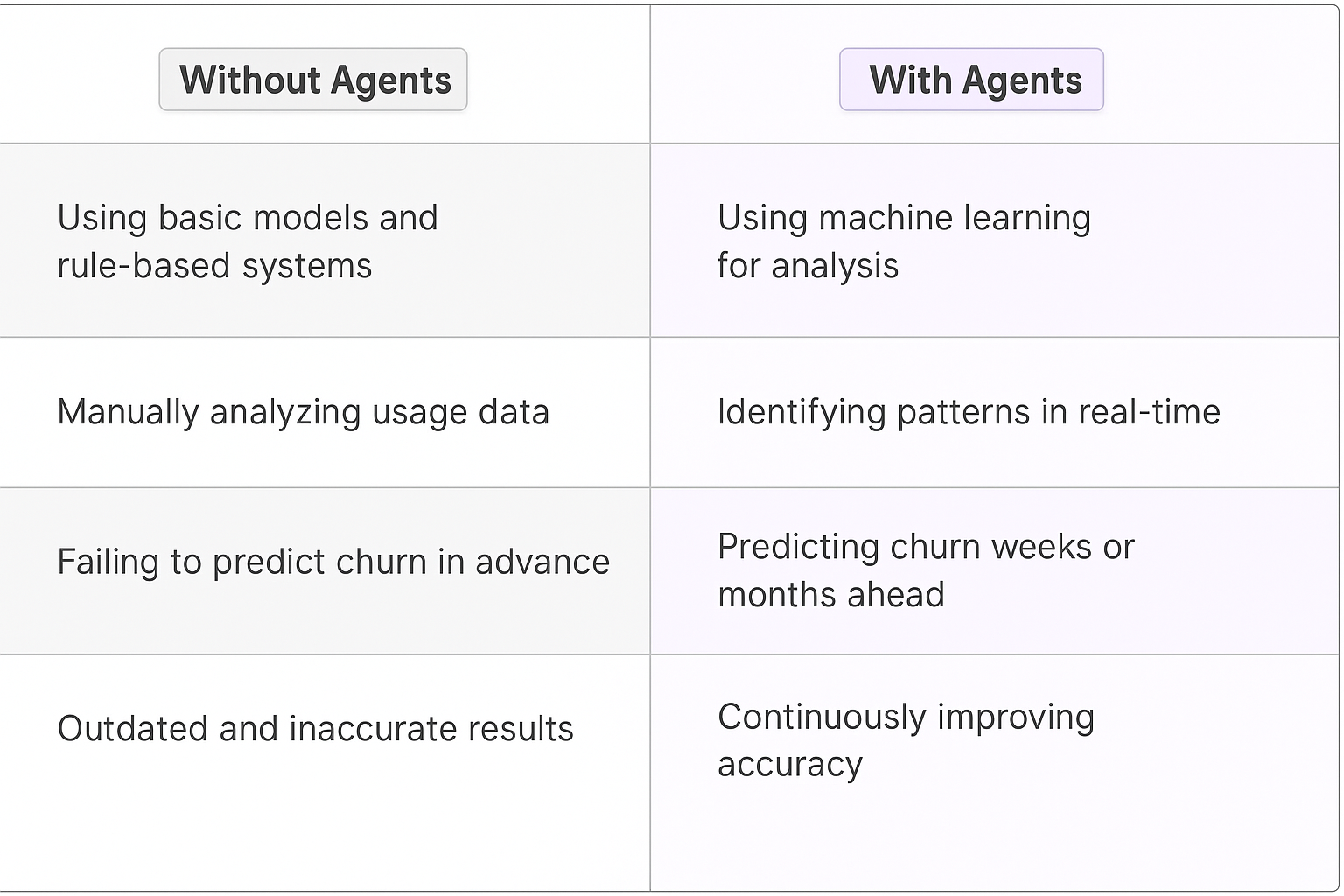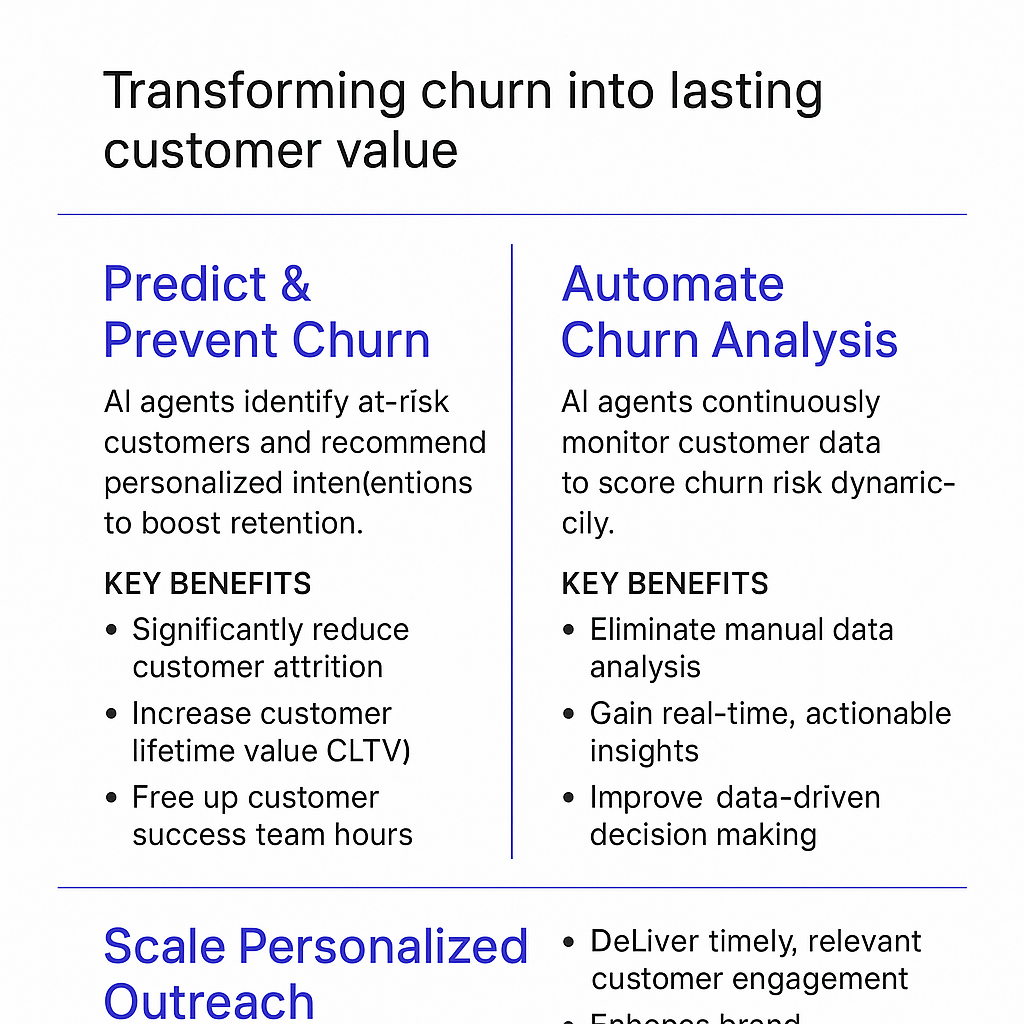Churn Prediction AI Agents
Understanding Churn Prediction and AI Agents in Customer Retention
What is Churn Prediction?
Churn prediction is the art and science of identifying customers likely to discontinue using a product or service. It's like having a crystal ball for your business, but instead of mystical powers, it uses data and algorithms. In the digital age, where customer acquisition costs are skyrocketing, keeping existing customers is more crucial than ever. Churn prediction allows companies to spot the warning signs early and take action before a customer walks out the digital door.
Key Features of Churn Prediction
Churn prediction isn't just about guessing who might leave; it's a sophisticated process with several key features:1. Data Integration: It pulls in data from multiple sources - usage patterns, customer support interactions, billing history, and more.2. Pattern Recognition: Advanced algorithms identify subtle patterns that humans might miss, like a slight decrease in login frequency or a change in feature usage.3. Risk Scoring: Each customer gets a churn risk score, allowing businesses to prioritize their retention efforts.4. Predictive Modeling: It doesn't just look at the past; it forecasts future behavior based on historical patterns.5. Actionable Insights: The best churn prediction tools don't just identify at-risk customers; they suggest specific actions to keep them engaged.6. Continuous Learning: These systems get smarter over time, constantly refining their predictions based on new data and outcomes.
Understanding customer data patterns is crucial for effective churn prediction, as it forms the foundation for all predictive modeling efforts.

Benefits of AI Agents for Churn Prediction
What would have been used before AI Agents?
Before AI agents entered the scene, churn prediction was like trying to navigate a maze blindfolded. Companies relied on basic statistical models, rule-based systems, and gut feelings. It was a world of spreadsheets, manual data analysis, and educated guesses. Customer success teams would spend hours poring over usage data, trying to spot red flags that might indicate a customer was about to jump ship.
These traditional methods were not only time-consuming but also painfully inaccurate. They often missed subtle patterns and failed to account for the complex interplay of factors that lead to churn. It was like trying to predict the weather with a wet finger in the air – sometimes you'd get it right, but more often than not, you'd be caught in the rain without an umbrella.
What are the benefits of AI Agents?
Enter AI agents for churn prediction, and suddenly we're playing a whole new ballgame. These digital teammates are like having a team of data scientists working 24/7, processing vast amounts of customer data at lightning speed. They're not just crunching numbers; they're uncovering hidden patterns and insights that human analysts might never spot.
One of the biggest benefits is the shift from reactive to proactive customer retention. AI agents can predict churn risk with uncanny accuracy, often weeks or months before a customer shows any obvious signs of dissatisfaction. This early warning system gives companies a crucial time advantage to intervene and turn things around.
But it's not just about prediction – it's about personalization at scale. AI agents can tailor retention strategies for each individual customer, considering their unique usage patterns, preferences, and history. It's like having a personal concierge for every single user, but one that operates at machine speed and scale.
The efficiency gains are staggering. Tasks that used to take teams of analysts days or weeks can now be accomplished in minutes. This frees up human talent to focus on high-level strategy and personal outreach where it matters most.
Perhaps most importantly, AI agents for churn prediction are constantly learning and improving. Every interaction, every data point, every outcome feeds back into the system, making predictions more accurate over time. It's a virtuous cycle of improvement that traditional methods simply can't match.
In the high-stakes game of customer retention, AI agents are like having a crystal ball and a supercomputer rolled into one. They're not just changing the rules – they're rewriting the entire playbook for how companies approach churn prediction and customer loyalty.
Potential Use Cases of AI Agents for Churn Prediction
Processes
Churn prediction AI agents are game-changers in the world of customer retention. They're not just fancy algorithms; they're digital teammates that can transform how businesses approach customer relationships. These AI agents dive deep into customer data, surfacing insights that human analysts might miss.
One key process these agents excel at is continuous monitoring of customer behavior. They're constantly on the lookout for early warning signs of churn, analyzing patterns in product usage, customer support interactions, and even social media sentiment. This real-time vigilance allows companies to intervene at the right moment, before a customer's dissatisfaction reaches a tipping point.
Another critical process is predictive modeling. Churn prediction AI agents don't just look at historical data; they use machine learning to forecast future behavior. They can identify which customers are most likely to churn in the next month, quarter, or year, allowing businesses to allocate retention resources more effectively.
Tasks
When it comes to specific tasks, churn prediction AI agents are versatile powerhouses. They can segment customers based on churn risk, allowing marketing teams to tailor their retention strategies. For high-risk customers, the AI might trigger personalized email campaigns or prompt a call from a customer success manager.
These digital teammates can also perform root cause analysis. By sifting through vast amounts of data, they can pinpoint the specific factors driving churn for different customer segments. Is it a recent price increase? A buggy feature? Poor customer support? The AI can tell you, enabling targeted improvements.
Another key task is churn impact forecasting. The AI can estimate the potential revenue loss from predicted churn, helping businesses understand the financial implications and justify investments in retention efforts.
Churn prediction AI agents can also optimize win-back campaigns. By analyzing the characteristics of customers who've churned and successfully been brought back, these digital teammates can identify the best candidates for re-engagement efforts and suggest the most effective strategies.
In the world of SaaS and subscription-based businesses, these AI agents are becoming indispensable. They're not replacing human judgment, but augmenting it, allowing businesses to scale their retention efforts in ways that were previously impossible. As these AI agents continue to evolve, we'll likely see even more sophisticated use cases emerge, further blurring the line between human and artificial intelligence in the realm of customer retention.

Industry Use Cases: Churn Prediction AI Agents
Churn prediction AI agents are reshaping how businesses approach customer retention across sectors. These digital teammates aren't just crunching numbers; they're decoding complex patterns of customer behavior that human analysts might miss. Let's dive into some industry-specific scenarios where these AI agents are making waves, transforming how companies anticipate and mitigate customer churn.
From e-commerce giants to subscription-based services, telecom behemoths to fintech startups, churn prediction AI is becoming the secret weapon in the battle for customer retention. These use cases will illustrate how AI agents are not just predicting churn but actively shaping strategies to keep customers engaged and satisfied. It's a game-changer, folks, and the companies leveraging this tech are seeing real, measurable impacts on their bottom line.
Churn Prediction AI in SaaS: The Silent Growth Killer
Let's talk about the SaaS industry's elephant in the room: churn. It's the silent killer that can torpedo even the most promising startups. Enter churn prediction AI agents - the digital teammates that could be the difference between a hockey stick growth curve and a flatline.
In the SaaS world, customer retention is the holy grail. A 5% increase in retention can boost profits by 25-95%. That's not just growth; it's rocket fuel. Churn prediction AI agents are the secret weapon in this retention battle.
These AI agents don't just crunch numbers; they're pattern recognition ninjas. They dive deep into user behavior data, spotting the subtle signs of a customer about to bounce. Maybe it's a drop in login frequency, a decline in feature usage, or an uptick in support tickets. To a human, these might seem like unrelated data points. To an AI, it's a clear distress signal.
But here's where it gets interesting. These AI agents don't just predict churn; they prescribe action. They can trigger personalized interventions before the customer even thinks about leaving. It could be a targeted email campaign, a customized in-app message, or a proactive reach-out from the customer success team.
The real magic happens when these AI agents start learning from the results of these interventions. They're constantly refining their models, getting smarter with each interaction. It's like having a customer success team that never sleeps, never forgets, and gets better every single day.
For SaaS companies, this isn't just a nice-to-have. It's survival. In a world where switching costs are low and competition is just a click away, keeping customers is as crucial as acquiring them. Churn prediction AI agents are the watchful guardians, the early warning system that could mean the difference between hypergrowth and stagnation.
The companies that embrace these AI agents aren't just playing defense; they're rewriting the rules of customer retention. They're turning churn prediction from a reactive scramble into a proactive strategy. And in the cutthroat world of SaaS, that's not just an advantage - it's the future.
Churn Prediction AI in E-commerce: The Customer Loyalty Game-Changer
E-commerce is a brutal battlefield. With countless options at their fingertips, customers can ghost you faster than a Tinder date. But what if you could predict - and prevent - these digital breakups before they happen? That's where churn prediction AI agents come in, and they're about to flip the script on customer loyalty.
Let's break it down. In e-commerce, customer acquisition costs are skyrocketing. We're talking $29 per customer on average, and that number's only going up. Retention isn't just nice to have; it's survival. A 5% boost in retention can jack up profits by 25% to 95%. That's the difference between being the next Amazon or the next... well, let's not go there.
Churn prediction AI agents are like having a crystal ball, but one that actually works. These digital teammates dive deep into the data ocean of customer behavior. They're not just looking at purchase history; they're analyzing everything from browsing patterns to cart abandonment rates, from email open rates to customer service interactions.
But here's where it gets really interesting. These AI agents don't just predict churn; they're proactive problem solvers. They can trigger personalized interventions that feel less like desperate pleas and more like mind-reading customer service. Maybe it's a perfectly timed discount on a product they've been eyeing, or a reminder about loyalty points they're about to lose. It's like having a sales team that knows exactly what to say and when to say it, 24/7.
The real magic happens when these AI agents start learning from their own interventions. They're constantly refining their models, getting smarter with each interaction. It's like having a customer retention team that never sleeps, never forgets, and gets better every single day.
For e-commerce players, this isn't just a nice-to-have. It's the new battleground. In a world where brand loyalty is as rare as a unicorn, these AI agents are the secret weapon. They're turning churn prediction from a guessing game into a science, from a reactive scramble into a proactive strategy.
The companies that embrace these AI agents aren't just playing defense; they're rewriting the rules of customer loyalty. They're not just predicting the future; they're shaping it. And in the cutthroat world of e-commerce, that's not just an advantage - it's the difference between being a category leader and a cautionary tale.

Considerations
Technical Challenges
Implementing a churn prediction AI agent isn't a walk in the park. It's more like trying to solve a Rubik's cube blindfolded while riding a unicycle. The first hurdle? Data quality. Your AI is only as good as the data it feeds on, and most companies' data is about as organized as a teenager's bedroom.
You'll need to wrangle data from multiple sources, clean it up, and make sure it's consistent. It's like being a digital janitor, but instead of a mop, you're wielding complex ETL processes. And let's not forget about the feature engineering aspect. You'll need to create meaningful variables that can actually predict churn. It's not just about having data; it's about having the right data.
Then there's the model selection and tuning process. It's like trying to find the perfect outfit for a first date, but instead of clothes, you're dealing with algorithms. Random forests, gradient boosting, neural networks - each has its pros and cons. You'll need to experiment, iterate, and fine-tune until you find the right fit for your specific use case.
Operational Challenges
On the operational side, things get even trickier. First off, you need to integrate this AI agent into your existing systems. It's like trying to introduce a new player to a well-oiled sports team mid-season. There will be friction, miscommunication, and a whole lot of "who moved my cheese" moments.
Then there's the challenge of getting buy-in from different departments. Sales might love the idea of predicting churn, but they might not trust a "robot" to do their job. You'll need to become part data scientist, part therapist, convincing everyone that this AI agent is here to help, not replace them.
Let's not forget about the ongoing maintenance and monitoring. An AI model isn't a set-it-and-forget-it solution. It's more like a high-maintenance pet that needs constant attention. You'll need to regularly retrain the model, monitor its performance, and make sure it's not drifting off course. It's a full-time job in itself.
Finally, there's the ethical consideration. How do you use this churn prediction information without crossing the line into creepy territory? It's a delicate balance between being proactive and respecting customer privacy. One misstep, and you could end up on the wrong side of a PR nightmare or, worse, legal trouble.
Implementing a churn prediction AI agent is no small feat. It's a complex, multifaceted challenge that requires technical expertise, operational finesse, and a good dose of perseverance. But get it right, and you'll have a powerful tool that can significantly impact your bottom line. Just remember, it's a marathon, not a sprint - and there will be plenty of hurdles along the way.
The Transformative Power of AI in Customer Retention
Churn prediction AI agents are more than just a technological advancement; they're a paradigm shift in how businesses approach customer retention. By harnessing the power of machine learning and big data, these digital teammates enable companies to move from reactive firefighting to proactive relationship management. They're not replacing human intuition and expertise; they're augmenting it, allowing businesses to operate at a scale and precision previously unimaginable.The impact of these AI agents extends far beyond just reducing churn rates. They're reshaping customer experiences, driving personalization at scale, and ultimately transforming how businesses create and maintain customer relationships. As these technologies continue to evolve, we can expect even more sophisticated applications, potentially redefining the very nature of customer loyalty in the digital age.For businesses looking to thrive in an increasingly competitive landscape, embracing churn prediction AI isn't just an option - it's becoming a necessity. Those who successfully integrate these digital teammates into their operations will find themselves not just retaining customers, but building deeper, more meaningful relationships with them. In the end, that's not just good for business; it's good for customers too.











